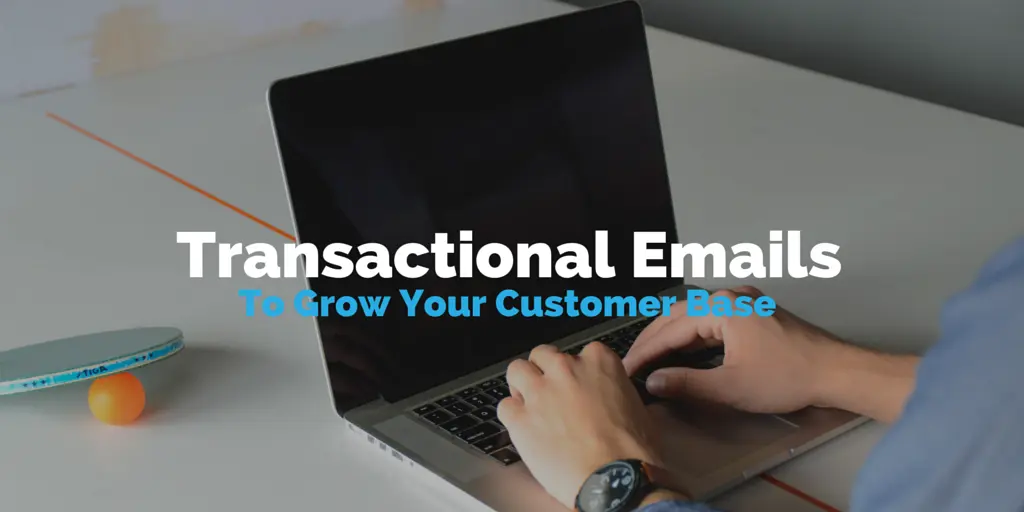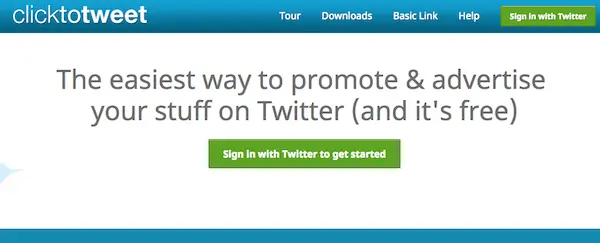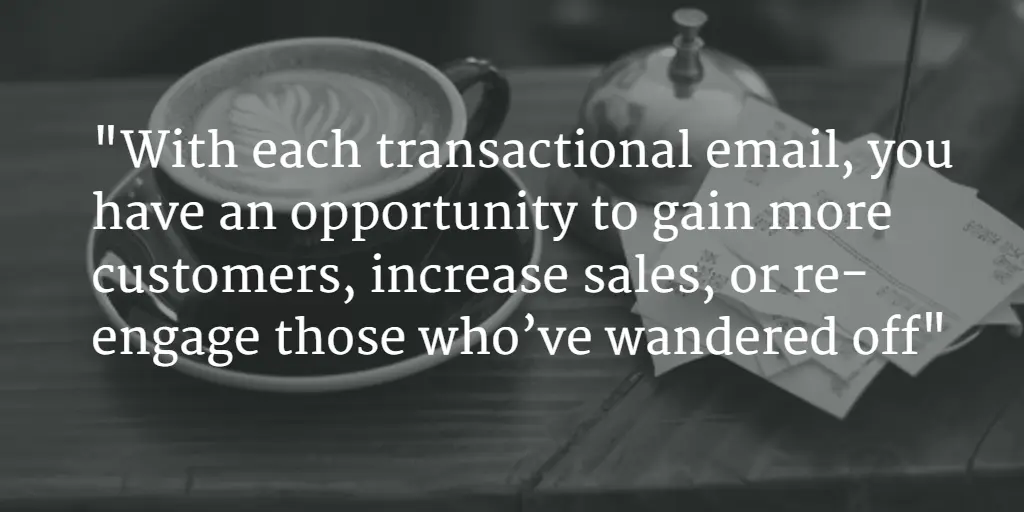
When you place an order online, do you expect a receipt waiting for you in your inbox? And if that receipt doesn’t arrive, then the order didn’t really happen, did it?
Or what about when you sign up for a cool email newsletter? You just know that there’s going to be a subscription confirmation letter waiting for you. And if one doesn’t race you to your inbox, then something’s wrong.
These special emails are known as transactional emails and, as you’ll soon discover, they are essential to growing and maintaining your customer base.
(Psst.. Be sure to stay until the end to get access to a list of free templates for your transactional emails. Or grab it now)
So, What Exactly is a Transactional Email?
The term “transactional email” sounds so impersonal but it’s actually the opposite. A transactional email is a highly relevant and personalized message sent one-to-one based on the user’s action.
Let’s make a big generalization and say that there’s two types of emails you’ll send to your customers: marketing and transactional. A marketing email is generic and sent to a large group. This is the type of email you would send to a sell a certain product or share news about your brand. A transactional email is targeted to one specific user, and is triggered by that user’s behavior.
Transactional emails are often called trigger-based or personalized emails for this reason. These types of emails have an exceptionally high open and click through rate compared to marketing emails (up to and more than 100% in some cases, according to this Experian study).
There’s a ton of different types of transactional emails, including (but not limited to) welcome, purchase confirmations, shipping notices, password reminders, and cart abandonment. Chances are, you have a couple of transactional emails waiting in your inbox right now.
Why You Need to Use Transactional Emails Effectively
Your customers expect transactional emails from you. Transactional emails help you build and maintain a relationship after the initial purchase, download, or sign up. It sets the tone for what customers should expect from interacting with your brand.
That’s right– the marketing doesn’t stop at your website. Your email is an important, but often under-utilized, extension of your brand. I’ve seen the friendliest, most personable websites paired with the most uninspiring, rote email personas.
The takeaway in this case is either: A) the company doesn’t understand how badly they come across in emails; or B) the company doesn’t care now that they have my money. Neither option is good.
It’s true that having a transactional email system in place is better than not having one at all. But, it’s also true that failing to maximize your transactional emails means that you’re missing an opportunity to nurture and grow your customer base.
The Best Ways to Use Transactional Email
With each transactional email, you have an opportunity to gain more customers, increase sales, or re-engage those who’ve wandered off.
Let’s take a look at the most common transactional emails, and how you can use them to you and your customer’s advantage. A win-win!
Welcome Emails
You’ve had the good fortune of winning a new subscriber, or you’ve made a sale. The first thing to do is send an email. Approximately 75% of customers expect a welcome email. Take this opportunity to be personal and say thanks. But, don’t forget to use your company’s tone to do so. If your brand is relaxed and casual, don’t force a formal welcome email.
Timing is also critical. You should opt for sending a transactional email within an hour after signing up. This is the time when your customer is most engaged with what you have to offer.
Best Call-to-Action: A welcome email is also the time to take the customer further down the rabbit hole. What is your preferred call to action? If the customer has signed up for your newsletter, take this chance to ask for a tweet. Use a service like Click to Tweet to set up the tweet and do the hard work for them. This can help build your referral traffic.

Purchase Confirmations and Receipts
A customer makes a purchase. It’s party time. But before you pass the margaritas, be sure that you’ve optimized your transactional email to anticipate buyer habits. Did you know that upselling drives approximately 4% of online sales? The perfect time to convince your customer is after they’ve committed to the sale. You can use your transactional email to entice with an irresistible offer for upgrade (along with compelling reasons to do so).
Best Call-to-Action: Go for a hard upsell, showing plainly the superiority of the higher priced offering. Depending on the product, it may be worthwhile to offer a free trial upgrade or a special, time sensitive discount.
Newsletter Subscription Confirmation
You have a brand new subscriber for your newsletter. They don’t know what to expect, so here’s your chance to lay it all out. After the obligatory opt-in, chase with another email that explains how frequently you’ll be sending emails. Share what topics you commonly discuss, in case you haven’t already.
Best Call-to-Action: If you dangled a special offer in exchange for joining your newsletter, you should link to that. The most effective call-to-action here is to give them what you’ve promised.

Thanks for Trying
If you’ve offered a trial and it’s coming to a close, send a transactional email that shows off your approachable side. Getting your customers involved in the process makes them invest more in your product. Ask questions about the customer’s experience with your product, but be sure to keep it short. Maybe include a poll or survey in this email.
Best Call-to-Action: Make it attractive for your customers to interact with you. Present your contact information (perhaps you should designate a staff member specifically for this role) and genuinely ask for feedback.
Cart Abandonment and Failed Transaction
The average cart abandonment rate is 68.53%. One of the most common reasons customers abandon their cart is because they’ve encountered problems on your site. Maybe your site crashed or timed out. Or maybe their payment was declined.
Did you know that you can woo your customers back with a transactional email? According to this research, up to half of cart abandoners can be remarketed. And, get this: those who do spend 55% more than they originally planned. It’s worth it to send a remarketing transactional email.
Best Call-to-Action: Within 24 hours, preferably immediately, send an email that shows what’s waiting in the cart. Create a sense of urgency with a special upgrade offer. Don’t miss this opportunity to cross-sell related items. This act will often reassure your customer that you offer a total solution to their problem.
Birthday and Anniversary
Does your customer have a special day coming up? Maybe a birthday or a customer anniversary? Use this time to give them something that lets them know you care. Grand gestures aren’t necessary, but a freebie is usually the best option here.
Best Practices
So, let’s look at the very best practices for creating transactional emails that rock.
- The subject line is your friend. To ensure that it gets read, your subject line should strike a familiar chord with your customer. Immediately and specifically identify the purpose of your email. For example:
Welcome aboard, X Customer! We’re happy you’re here, mate.
Here’s the details of your order with X company:
Uh-oh. Something went wrong
- Don’t overlook your sender name. Similar to subject line, your sender name should be descriptive and inviting. No one wants to deal with a “donotreply@yourbusinessname.com.” It’s very harsh and impersonal. Instead, go for “anna@yourbusinessname.com” or Paul @ Your Business Name.
- Always say thank you. You can never say thank you enough, especially when you’re being sincere. Make sure that every email you send includes a big ole thank you at least once.
- Use a call-to-action. End each email with the desired action you’d like the reader to take. That may be to shop, to sign up for your newsletter, or to join your social media page.
- Be friendly. Your email may be automated, but it shouldn’t sound soulless. Remember to be a human talking to a human. That’s how you’ll win customers over.
Are you ready to maximize your transactional emails? Check out our list of free transactional email templates along with killer examples. Get your copy here.